If you are shopping for hoses, one of the biggest decisions you have to make is what hose material best fits your needs. Rubber hoses are very popular due to how durable and flexible they are. But what about kinking? Do rubber hoses kink?
Yes, rubber hoses do kink. Rubber hoses are very flexible and easy to maneuver, but because they are so flexible, they are also prone to kinking. If you prioritize kink-resistance, a premium vinyl hose that uses multiple layers of reinforcement may be a better option.
Some rubber hoses are marketed and designed to be “kink-resistant”, but I would caution you – these rubber hoses still (in most all cases) will not be as kink-resistant as a vinyl hose that has been reinforced with multiple layers to prevent kinking.
A reinforced vinyl hose uses extra layering that basically forces the hose to hold its form and shape. The tradeoff is these reinforced hoses are very stiff and not as easy to maneuver.
Despite kinking, rubber hoses are still a great choice because the material is very durable and very flexible. But because they are flexible, they will kink. In this article let’s take a closer look at why rubber hoses kink, what your other options might be, and what you can do to reduce kinks in a rubber hose.
Table of Contents
Will Rubber Hoses Kink?
As we discussed above, yes, rubber hoses do kink. Rubber hoses are very flexible and easy to maneuver, but because they are so flexible, they are also prone to kinking.
Although some may be marketed as being “kink resistant”, in general, they don’t have the same kink-resistant properties that premium vinyl hoses have. For example, here’s what happened when I straightened out a rubber hose last week:
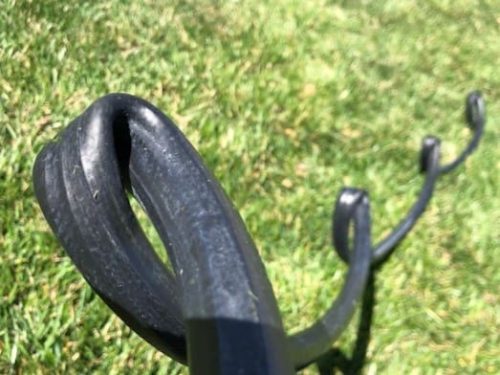
You often find advice from “experts” claiming that rubber hoses are kink-resistant. This is just not true. Yes, rubber hoses are great. They are durable, easy to maneuver, and can last a long time – but they will kink.
For illustration, in the video below, I straighten out a rubber hose that I just pulled out of the garage. Notice how easily it straightens (not stiff), but yes, does form some kinks also:
Although the rubber hose above kinked, the material is much more responsive to user control. Because the rubber material isn’t designed to hold a specific shape, it will respond much better when you swing it around in the yard or maneuver it around your garden.
If you prioritize kink-resistance, you may want to consider other hose materials. What other hose materials are best at resisting kinks?
What Hose Materials are Better Than Rubber at Resisting Kinks?
To make a hose kink-resistant, companies will use multiple layers of material to reinforce and strengthen the hose, and help it hold its shape. This usually results in a heavier, stiffer hose that does resist kinking. For lightweight hoses, instead of adding extra layering (which adds weight), some companies instead choose to wrap the hose in some sort of braiding or coiling to help the hose hold structure.
Ultimately, the purpose of the hose usually impacts how a company designs it to be kink resistant. For example, if a hose company wants to make a hose that is both flexible and kink-resistant, they can’t use extra layering to accomplish that, because the layering would remove the flexibility.
In a case like that, a company may turn to another tactic (like a wrapped coiling down the hose) that helps discourage kinks, but doesn’t kill flexibility as much as adding extra layering does.
Vinyl, nylon, metal, and polyurethane (or polypropylene) are hose materials that can be more kink resistant than rubber. Let’s discuss some examples, and the pros and cons of these types of hoses.
Vinyl
Vinyl can be both good and bad. Cheap hoses are made of vinyl, and will kink frequently. But there are also premium vinyl hoses that use extra layering to reinforce the hose, and help it maintain shape.
These premium vinyl hoses, in my experience, are the most kink-resistant hoses on the market. But it comes at a cost. These hoses are very stiff, and not as easy to maneuver as a rubber hose.
For example, here is a vinyl hose that I own. Not only has this company used extra layering, but there is also a braiding throughout the hose to help it maintain its shape. If you look closely, you can see the braiding in the hose:
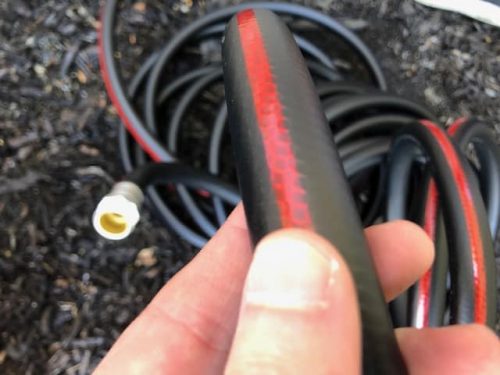
These premium vinyl hoses are very good at maintaining their form and shape. In fact, they’re almost too good at it. The hoses can be stiff and hard to maneuver around a yard (compared to a rubber hose). For example, here I am straightening out a premium vinyl hose that I own:
You’ll notice that even when it starts to tangle, the hose adjusts itself and resists kinking due to this reinforced layering. But you’ll also notice that it also doesn’t straighten completely out. This isn’t a hose that you can easily whip around a yard.
But these types of premium vinyl hoses are very durable and very kink resistant. If you are someone who prioritizes kink-resistance, this may be your best option.
Polypropylene
Polypropylene is a lightweight material that is often used in hoses designed for ease-of-use. For example, maybe you are looking for a lightweight, super-flexible hose to use for a small garden in your backyard.
Again, the problem here is a company can’t use extra layering to make the hose kink-resistant, because that in turn would cause the hose to weigh more and lose its flexibility (defeating the purpose). In this case, a hose company may use a wrapping along the hose to help it hold shape.
For example, here is a polypropylene hose that I own. As you can see, it has a blue coiling that wraps the outside of the hose and helps hold the hose’s shape and structure to prevent kinking.
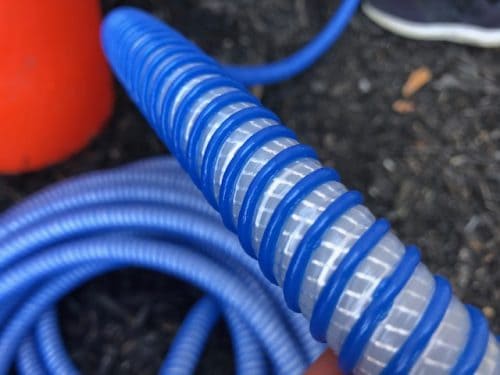
This hose is super lightweight, and very flexible, but still resists kinking. Here I am straightening out this polypropylene hose:
As you can see, every time the hose started to bend and potentially kink, the coiling snapped it back straight and prevented the kink. Now, to be clear, polypropylene itself is very lightweight, and not all poly hoses will resist kinking. But this hose, because of that coil wrap, does.
Metal
Yikes, a metal hose? Yeah, that’s what I thought too when I first tried them. I was *shocked* at how easy they were to use, and how much I liked them.
The strength of a metal hose is they are (for the most part) pet-proof and chew resistant. If you have a dog that likes to chew on everything, these metal hoses can solve your problem.
But the benefits don’t just stop there. Metal hoses are very kink-resistant, and in my experience, basically impossible to kink. For example, here I am straightening out my favorite metal hose:
These hoses are very lightweight and very easy to maneuver. Here is a close-up look at the stainless steel material that is designed not to get hot in the sun:
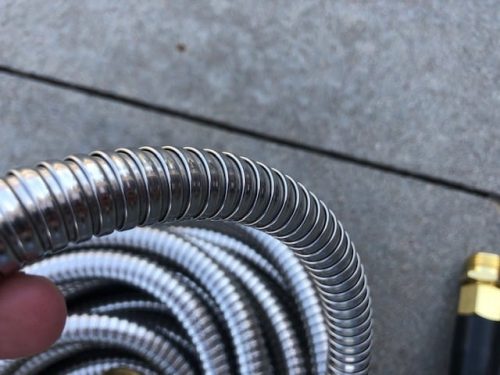
These are another great option if you hate kinking. But here’s where I would caution you: these hoses have a smaller diameter than standard garden hoses, which means the flow rate overall will be worse. If you rely on efficiency, I would stick with vinyl or rubber hoses.
Nylon
Nylon is the material used in most expandable hoses (also called pocket hoses). Some expandable hoses may use polyester, and will have basically the same results as nylon.
An expandable hose is sort of a gimmick, but it does serve a purpose. These hoses are ultra-lightweight (like, much lighter in weight than a normal hose), and are easy to store. And, yes, these hoses are practically kink proof.
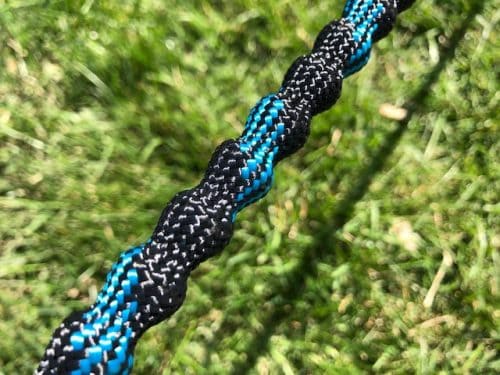
The material is designed to stretch and retract as you move, much like a rubber band would. This design basically eliminates the chances of kinks.
What’s the drawback? These hoses are not as durable as rubber and premium vinyl hoses, and they have a smaller diameter, leading to a worse flow rate and less efficiency. These hoses are best for small tasks, like watering flowers near the spigot.
3 Ways To Prevent Kinking in Rubber Hoses
Okay, you’ve decided you want rubber because it is such a durable material, and so easy to use. How can you help prevent some of the kinking that comes with rubber hoses? Here’s three tips I would recommend from experience.
Use a Strain Relief Kink Preventer
The most frequent spot for a kink to form is near the water spigot. As the hose moves around the yard, the hose may get twisted near the spigot.
To prevent kinking here, some companies will add a kink preventer (also called a “strain relief”) near the fitting of the hose. For example, here is a kink preventer on a hose I own:

This kink preventer can have several different designs. Here is another kink-preventer that I own, that almost look like a spring coiled around the end of the hose:
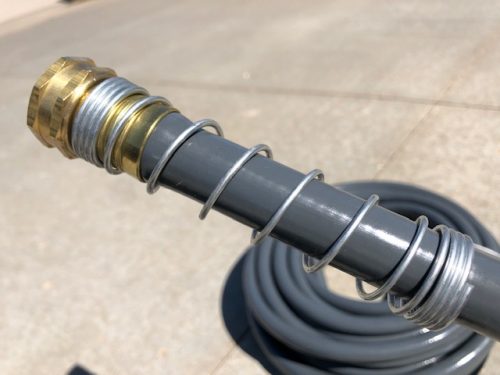
It wouldn’t hurt to shop for a rubber hose that came with one of these kink preventers. But if your favorite rubber hose doesn’t have one, you can buy kink preventers from your local hardware store to add to the hose.
Store the Hose Properly
It is very important to store your rubber hose correctly to keep your hose from kinking and to help it last as long as possible. There are two common ways to store your rubber hose.
- Wind the hose up and store it on a hook or on a shelf. Make sure there aren’t any kinks.
- Buy a wall mounted or metal hose reel cart to keep your hose stored without kinks. Garden hose stands also work.
Obviously storing your hose on a hook or shelf is less expensive. While using a hose reel may be more expensive, it does help you make sure you are storing the hose properly. When buying a hose reel, always make sure you buy one large enough for your hose.
Regardless where and how you store your hose you should store it out of the sun. Storing your rubber hose out of the sun will keep your hose in better working condition which will help prevent kinking.
Straighten the Hose Prior to Use
Take the time to straighten out the hose before turning on the water. This helps ensure that there are no trouble spots just waiting to kink once water pressure is applied.
So instead of attaching the hose to the spigot, turning on the water, and walking to your destination, stretch the hose out all the way to where you will be working first, then go back and turn on the water.
How Can You Get Kinks Out of a Rubber Hose?
A water hose kinks when its natural shape is disrupted (due to various reasons), causing a pressure point to form in the hose. This twisted angle of the hose reduces flow rate, and is a pain to deal with. Some of the reasons a water hose will kink include:
- The hose is made of low-quality materials
- The hose was not straightened prior to use
- The hose was not stored properly
- The hose is old and the materials are degrading
If you do have kinks in your garden hose, here are some simple things to help you remove the kink, and help protect the hose from damage.
- Find the spot where your garden hose is kinking. Then, unbend it and straighten it to allow the water to flow through the hose smoothly.
- After you have removed the kink, allow the water to run through the hose at a relatively high pressure to restore the shape of your garden hose.
- Finally, when coiling the hose for storage, make sure the problem spot doesn’t form another kink. Storing a hose with a kink in it is a great way to ruin a hose.
Unfortunately, as we have discussed, although rubber hoses are durable and flexible, they are not great at resisting kinks. If you need a kink-resistant hose, I’d recommend a premium vinyl hose that uses extra layering for support.
